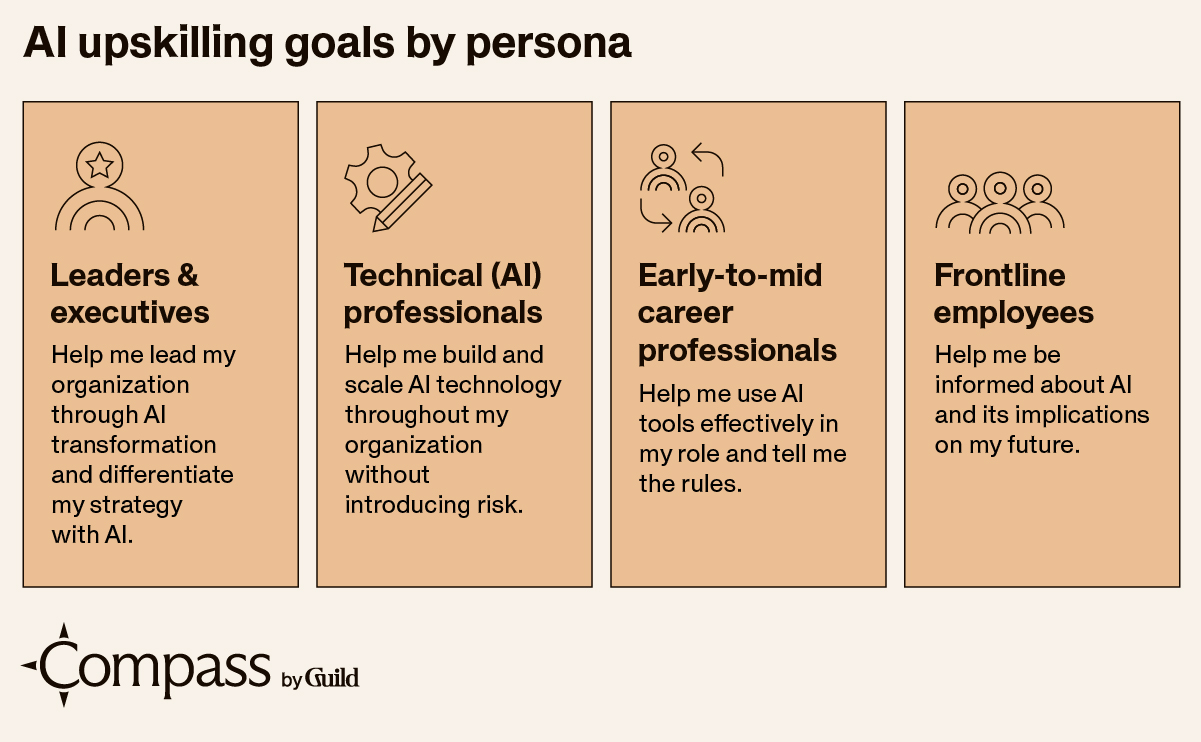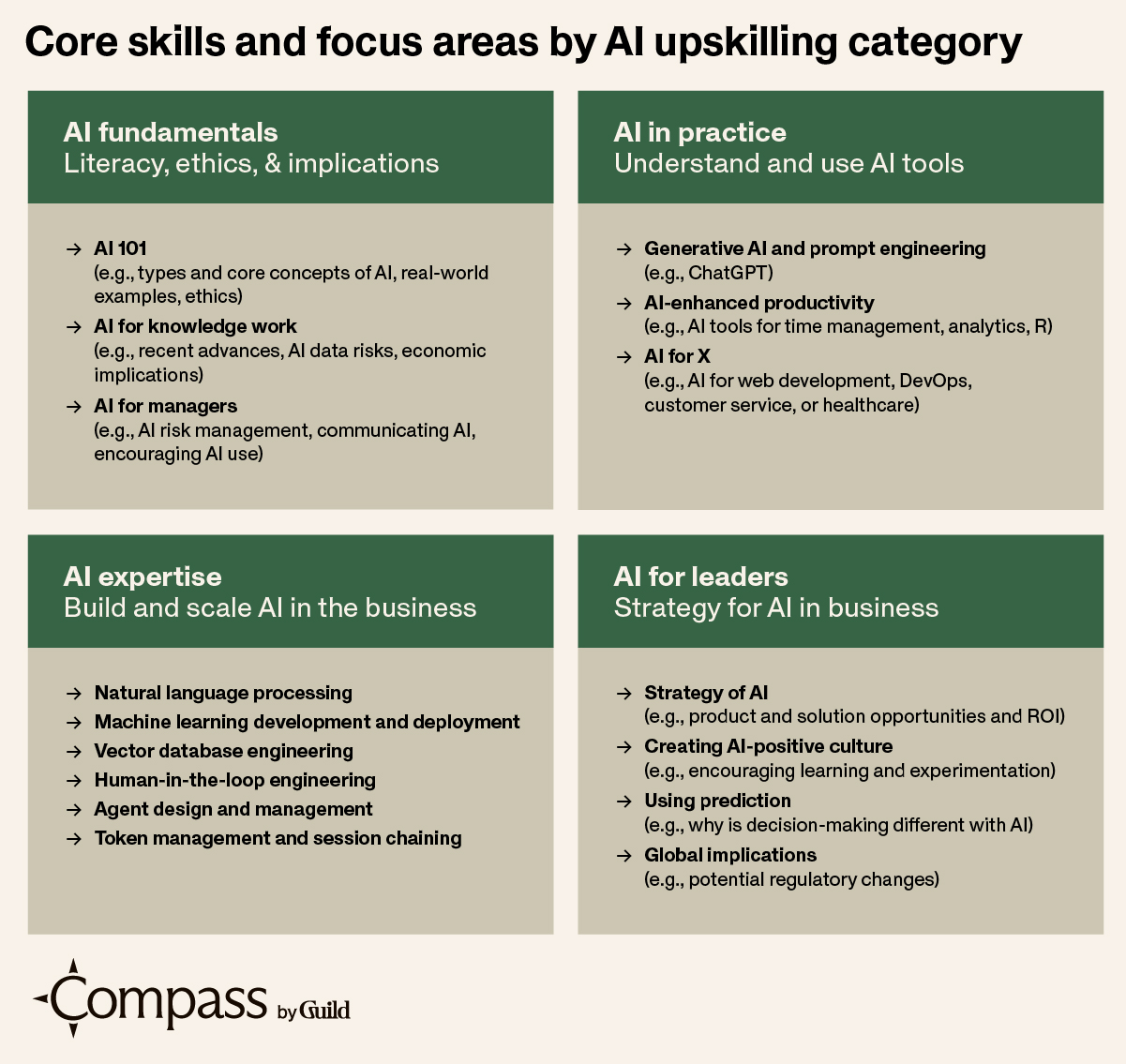Matthew Daniel |
A year and a half has passed since generative AI captured the public imagination and my own. Since then, we’ve seen feverish forecasting give way to enterprise experimentation (and, in some cases, serious AI upskilling). In this short amount of time, we’ve heard the conversation change from “What is gen AI and how will it impact my business?” and “How might we use it?” to “How will we prepare our people to have the skills to lead this shift?” and “How far behind are we, really?” And, at the extreme end: “Is it too late for our organization and our people?”
In this second edition of Guild’s roadmap for upskilling your workforce on AI, I lay out the context of our current AI moment and a set of steps to follow as you get your organization on the right track with AI. You’ll gain ideas and resources to take back to your teams to help with the following:
Understanding today’s adoption moment;
Preparation through self-skilling and experimentation;
Building personas to guide targeted learning;
Defining the right skill categories for your people; and
Leading with business impact in mind.
1. AI transformation is arriving in increments, not earthquakes.
Equip your workforce for AI’s measured rise.
For all the headlines and hype, most organizations have yet to realize sweeping business-wide transformation from AI. That’s not a failure of the technology or strategy but a reflection of the time it takes for meaningful change to actually take root across an organization. As MIT Sloan’s Melissa Webster and George Westerman noted recently, leading companies are finding value in what they call “small t” transformations: targeted, measurable improvements that build momentum for larger-scale change over time.
This reality should reframe how leaders think about workforce resilience. Rather than preparing for a single seismic moment, organizations should equip teams to engage with AI in more iterative, practical ways.
For HR and learning leaders, your skilling strategies should match the pace and shape of the transformation that’s happening in earnest. Invest not only in foundational knowledge, but in creating the conditions for experimentation, collaboration, and continuous learning. That could mean embedding new tools into workflows, developing new processes around successful AI pilot programs, and workshopping how to apply AI ethically and responsibly.
To guide your approach, ask:
Where are the small-scale transformations already underway in your business — and how can existing and newly learning programs accelerate them?
Who are the internal AI champions that will build with me, and how do I identify the most significant needs we can work to address together?
Which additional AI tools should my teams and I start experimenting with to build credibility and better understanding?
But if we’ve learned anything from the last wave of disruption, it’s that timing and leadership matter. The current AI moment echoes the early days of digital transformation, offering HR a second chance to lead.
2. Remember the lessons from your digital transformation.
Lead AI learning from the start.
As we all remember, too many HR teams sat out the early years of digital transformation, ceding control of upskilling to other functions. In doing so, they missed the chance to shape strategy, influence investment, and position HR as a growth driver.
We can’t afford to make that mistake with AI.
The HR leaders who made it through the years of “digital transformation” were those who embraced “digital,” defined it, created upskilling programs, and realigned staff accordingly. In the case of AI, now is the time to choose your path and decide if you will define the skilling agenda or leave it to the business.
To be clear, HR should absolutely partner with other functions to drive the learning agenda and ensure the most essential needs of your organization are being addressed. My caution to HR leaders is simple: Lean in and stay connected to the decisions around how, what, when, and where AI learning happens.
3. One-size-fits-none: Why you need AI personas
Your workforce needs learning that matches who they are.
At Guild, we’ve worked with dozens of large employers who have asked the same question: “Where do we start with AI skilling?” One thing we’ve learned over the past 18 months is that AI readiness looks different depending on the role, industry, and learner.

A persona-based framework helps employers move beyond generic “AI 101” courses. Instead, it enables targeted learning plans for everyone — from frontline workers experimenting with AI for the first time to senior leaders embedding it in business strategy.
Data from Guild programs underscores this need:
23% of Guild’s AI learners are frontline employees; and
10% are senior leaders, including directors and above.
And before you begin to imagine that you just need a series of Youtube videos to build the skills needed, you should know that the programs these frontline learners and executives were in lasted weeks, if not months. These findings reflect a broader shift in AI’s transformative impact on business: Skilling is for everyone and desired by every persona.
4. Invest in skills, not just tools.
*And skills that scale.
Today’s AI learners are trying to catch up to AI and get ahead at the same time. At Guild, we’ve seen more than 6,000 employees enroll in AI programs across 35 offerings from 10 top learning partners, including MIT, Purdue, and Oxford.
While the categories of relevant skills will undoubtedly evolve over the next few years, we’ve focused on what we believe are the most foundational skills that will continue to serve employees well even when new and increasingly innovative technologies are released.
Here are the four categories of our programs:
AI Fundamentals: Building literacy and ethics around the use of AI and developing the ability to consider the implications of AI on your work.
AI in Practice: Understanding the landscape of AI tools available and identifying when and how to practice using those tools in their roles.
AI Expertise: More technical skills that offer learners the ability to build and scale AI in their area of business.
AI in Leadership: Empowering leaders to incorporate AI into their business strategy and eventually evolving to an AI-driven strategy.

It’s also important to note that those who are leaning in to learning AI are also those who are seeing personal benefits from this growth mindset. While it’s important for personal resilience to build AI skills for the roles they’re in today, these programs are also producing measurable career outcomes for the learners:
2.2x salary uplift among AI learners compared to peers who didn’t participate
1.6x higher internal mobility for AI learners
The most in-demand skills? While machine learning, AI, and computer science top the list, learners are also building in management and business strategy, proving that AI fluency must span both hard and soft skills.
Regardless of the category or level of an employee’s AI proficiency, leaders must ensure that programs meet learners where they are and provide content that is both high quality and immediately applicable to their work. There are many strategic decisions that can maximize the value of AI-skilling investments, but the quality of learning experiences — defined not just by production value or expert credentials, but by practical relevance and usefulness — will be a key differentiator.
Employees should walk away from the experience not only knowing more about AI, but with the ability to apply what they’ve learned to their day-to-day and long-term work. In this era, the success of AI learning initiatives hinges less on the volume of offerings and more on the impact of each one. High-quality programs cultivate the ability to learn from AI, and to think critically about its use moving forward—even after the formal training ends.
5. Embrace AI’s power as a workforce equalizer.
Unlock AI’s full potential by expanding access to the people too often left out.
AI adoption has historically favored younger, white, male, and higher-income workers. A recent McKinsey survey found that millennials are the most active generation of gen AI users, with 62%of employees aged 35 to 44 reporting high levels of expertise, compared with 50% of 18- to 24-year-old Gen Zers and 22% of baby boomers over 65. And according to a Harvard Business School study, women use generative AI less than men in data from 18 studies covering 143,008 people from across the world, as well as data on who uses top generative AI websites and apps. Even when presented with the chance to use generative AI, the study found, women are less likely to use gen AI than men.
But it doesn't have to — and shouldn’t — stay this way. Guild’s data already tells a different story.
42% of our AI learners are women, compared with ~30% in the broader AI workforce, and
35% are aged 45 and up — double typical benchmarks.
We also see promising trends in AI learning among marginalized groups. Some 63% of Guild’s AI learners are from historically underrepresented populations.
We must also not forget that AI is built by humans and deployed in systems and institutions that have been marked by discrimination, and bias is often baked into the outcomes the AI is asked to predict and then used to train the AI.
“The biggest barrier to AI’s success... isn’t the technology — it’s people.”-
- Harvard professor Joseph Fuller
But these numbers show what’s possible when learning programs are designed with equal access in mind, and dispel the myth that AI will remain an economic benefit for the elite. As AI reshapes job roles and rewrites workflows, we must ensure that opportunity expands for everyone, particularly older workers who are proving to be a catalyst for AI adoption. It’s only when AI skills are made widely accessible that the full American workforce can contribute to and benefit from this transformation.
Final thoughts.
The AI headlines are changing. But the real work is just beginning.
HR leaders now have a chance to define what skills matter, design pathways that work, and create the kind of workforce that can power the business through the next decade.
As Harvard professor Joseph Fuller said at Guild's 2024 Opportunity Summit, “The biggest barrier to AI’s success... isn’t the technology — it’s people.”
Some big questions we should all be asking:
What skills are we investing in for our people in this new AI era? And why?
What tasks are being replaced today? What about five years from now?
Do we have a system in place to audit AI outputs for accuracy and ethics?
What durable and soft skills will differentiate our workforce?
Despite the small “t” transformations, most organizations are underinvesting in upskilling employees to work effectively alongside AI. This supports your call to action that AI skilling must be a workforce-wide initiative, not a technical side project.
The organizations that succeed won’t be the ones that simply adopt AI tools. They’ll be the ones that prepare their people to use them with purpose, confidence, and creativity.
And that starts with you.



